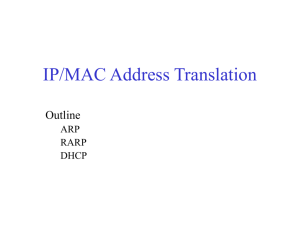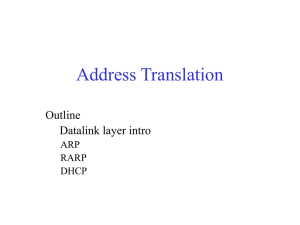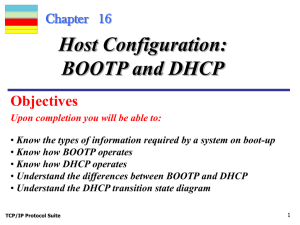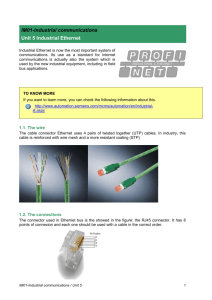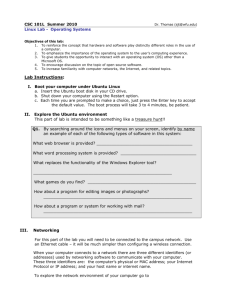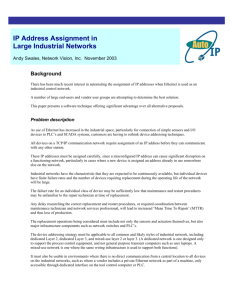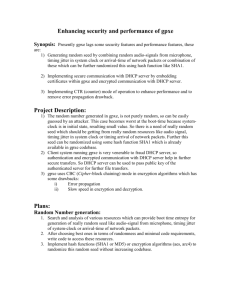Boot(ing) protocols - From (R)ARP to BSDP
advertisement
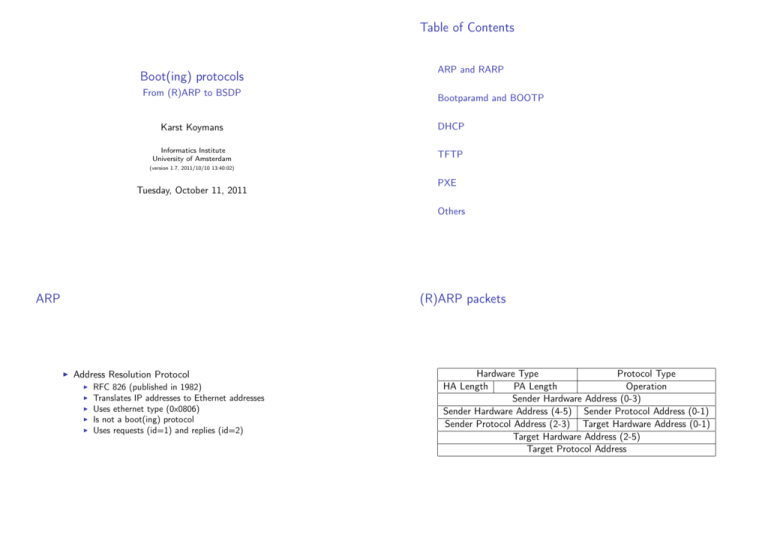
Table of Contents Boot(ing) protocols From (R)ARP to BSDP ARP and RARP Bootparamd and BOOTP Karst Koymans DHCP Informatics Institute University of Amsterdam TFTP (version 1.7, 2011/10/10 13:40:02) Tuesday, October 11, 2011 PXE Others ARP (R)ARP packets I Address Resolution Protocol I I I I I RFC 826 (published in 1982) Translates IP addresses to Ethernet addresses Uses ethernet type (0x0806) Is not a boot(ing) protocol Uses requests (id=1) and replies (id=2) Hardware Type Protocol Type HA Length PA Length Operation Sender Hardware Address (0-3) Sender Hardware Address (4-5) Sender Protocol Address (0-1) Sender Protocol Address (2-3) Target Hardware Address (0-1) Target Hardware Address (2-5) Target Protocol Address RARP ARP packet fields Hardware Type Protocol Type HA Length PA Length Operation Sender Hardware Address Sender Protocol Address Target Hardware Address Target Protocol Address 1 means Ethernet 2048(=0x0800) means IP 6 for Ethernet 4 for IP 1(request), 2(reply) ethernet source address source IP address ?(request), !(reply) destination IP address I Reverse Address Resolution Protocol I I I I I Requests (id=3) use I I I RFC 903 (published in 1984) 6= Inverse Address Resolution Protocol (other ether ⇒ IP) Translates own Ethernet address to own IP address Uses its own ethernet type (0x0835) (Ethernet) broadcast address as destination Own hardware address as source Replies (id=4) fill in the looked up IP address I For instance using /etc/ethers file Note that sender and target are swapped on reply The resulting information is in the Sender Hardware Address (R)ARP packets RARP packet fields Hardware Type Protocol Type HA Length PA Length Operation Sender Hardware Address (0-3) Sender Hardware Address (4-5) Sender Protocol Address (0-1) Sender Protocol Address (2-3) Target Hardware Address (0-1) Target Hardware Address (2-5) Target Protocol Address Hardware Type Protocol Type HA Length PA Length Operation Sender Hardware Address Sender Protocol Address Target Hardware Address Target Protocol Address 1 means Ethernet 2048(=0x0800) means IP 6 for Ethernet 4 for IP 3(request), 4(reply) ethernet source address undefined ethernet (source!) address ?(request), !(reply) Note that sender is changed and target stays the same on reply Bootparamd I I I Gets client name and IP address I Gets NFS server and root directory I I BOOTP packet format Operation Code Hardware Type Hardware Length Transaction Identifier Seconds Elapsed (Unused) Client IP Address Your IP Address Server IP Address Relay IP Address .. . RFC 951 (published in 1985) with clarifications in RFC 1532 (published in 1993) BOOTP Vendor Information Extensions I RPC/bootparams/getfile I Bootstrap protocol I Not much used outside SunOS/Solaris RPC/bootparams/whoami I I I Introduced by Sun, uses remote procedure call I I BOOTP RFC 1048, 1084, 1395 (published in 1988; obsolete) RFC 1497, 1533 (published in 1993; obsolete) RFC 2132 (with DHCP options) updated by RFC 3442, 3942, 4361, 4833 BOOTP packet format (continued) Hops .. . Client Hardware Address .. . (16 bytes) Server Hostname .. . (64 bytes) Boot Filename .. . (128 bytes) Vendor Specific Area .. . (64 bytes) BOOTP fields BOOTP fields (continued) BOOTP fields BOOTP fields Opcode Hardware Type Hardware Length Hops Transaction Identifier Seconds Elapsed 1 (request), 2 (reply) 1 (ethernet) 6 0 (for client), increased by relay number to match request and reply number of seconds since boot BOOTP fields (continued) Client IP Your IP Server IP Relay IP filled in by client (if known) provided by boot server address of boot server address of relay server BOOTP versus RARP BOOTP fields Client Hardware Address Server Hostname (sname) Boot Filename (file) Vendor Specific Area ethernet address of client optional name of wanted server set by client (and by server) server supplied full path boot file possibly hinted by client on request used for various extensions to BOOTP I RARP is link layer, needs kernel modification I RARP only supplies IP address BOOTP is UDP/IP based I I I Chicken/egg problems (client cannot reply to ARP) BOOTP supplies more information DHCP DHCP packet format Operation Code I Dynamic Host Configuration protocol I I Hardware Type Hardware Length Transaction Identifier Seconds Elapsed Flags Client IP Address Your IP Address Server IP Address Relay IP Address .. . RFC 2131 (published in 1997) DHCP Options and BOOTP Vendor Extensions I RFC 2132 (published in 1997) DHCP packet format (continued) .. . Client Hardware Address .. . (16 bytes) Server Hostname .. . (64 bytes) Boot Filename .. . (128 bytes) Options .. . (variable number of bytes) DHCP versus BOOTP I DHCP has more space for options I DHCP can overload sname and file fields DHCP can configure unknown clients I I I combines static/dynamic assignments DHCP has many more states, uses leases Hops DHCP fields Same as BOOTP with some extensions I Flags I Server IP address is the address of the next bootstrap server I Options instead of vendor extensions DHCP options (continued) Generic, IP, TCP, Application server/service options, for instance I I I I I Domain Name Server Option Interface MTU Option TCP Keepalive Interval Option Simple Mail Transport Protocol (SMTP) Server Option DHCP specific, like I I At the moment only the “broadcast flag”, for clients that can not receive unicasts before having an IP address configured I I DHCP options I I Requested IP Address IP Address Lease Time Option Overload DHCP Message Type (DHCPDISCOVER, DHCPOFFER, DHCPREQUEST, DHCPDECLINE, DHCPACK, DHCPNAK, DHCPRELEASE, DHCPINFORM) TFTP I Trivial File Transfer Protocol I I I RFC 1350 (published in 1992) Uses lock-step protocol Revision 2 I fixes a bug called “Sorcerer’s Apprentice Syndrome” PXE BSDP I Preboot eXecution Environment I I I Uses (slightly modified) DHCP Uses (possibly multicast) TFTP Defines own boot protocol using DHCP packet format I Has support for multiple TFTP servers I Boot Service Discovery Protocol I Works within DHCP context and uses I I Request: Vendor class identifier (option 60) Response: Encapsulated vendor-specific options (option 43)
